A New Wireless CROS and BiCROS Solution
By Stefan Petrausch, PhD, Alastair Manders, PhD and Karen Jacobus, AuD
Canadian Audiologist - vol. 3, issue 4, 2016
While the majority of individuals with hearing impairment have hearing loss in both ears, 10% or so of this population have a unilateral condition. Of this group, for many, the impaired ear is unaidable, and this condition often is referred to as single-sided deafness. While these individuals do commonly have a severe-to-profound sensorineural hearing loss in the impaired ear, “deafness” may not be the best descriptor, as other conditions are sometimes present that render the ear unaidable (e.g., very poor speech recognition, unique middle ear condition, etc).
Unilateral hearing loss can cause several communication problems—the most notable relates to reduced audibility when someone is talking from the side of the impaired ear. The attenuation of sound caused by the head, referred to as the “head-shadow effect,” is greater than 10 dB for the important higher frequencies of speech required for understanding. The degree of attenuation may prevent important soft speech sounds from being audible in the good ear.
People with a unilateral hearing loss also have more difficulty understanding speech in background noise. This is because they do not have the benefit of binaural redundancy (hearing the same message twice) and binaural squelch (a central auditory SNR improvement provided by comparing bilateral signals). Finally, these patients also have impaired localization ability, as time and intensity comparisons of signals between ears are not possible. The issues mentioned here can be especially troublesome in demanding listening environments. Research with school-age children, for example, has revealed that over 30% of the population with unilateral hearing loss will fail at least one grade in school, compared to only 3% of their normal-hearing counterparts (Bess et al, 1986).
Given that it is not possible to provide these patients with “two-eared” listening, the next best approach is to provide “two-sided” listening. This can be accomplished by transmitting the signal from the bad ear to the good ear. The practical application of this in wearable hearing aids was first reported by Harford and Barry in 1965. The hearing aids they described provided contralateral routing of offside signals, and were dubbed the CROS. These early models commonly used wires embedded in the frames of eyeglasses to accomplish the transmission. In the 1970s, developments allowed for radio frequency “wireless” transmission, and this technology soon became available using BTE instruments (see review by Teder, 2014).
The CROS fitting application is designed for individuals who have normal hearing in the “good” ear. Many patients, however, with an unaidable hearing loss in one ear, also have some hearing loss in the good ear. If, when viewed independently, the good ear would be considered aidable, then the fitting would be a BiCROS; bilateral microphones with the signal of the worse ear routed contralaterally. That is, signals are picked up on both sides of the head, but only delivered to the best ear. Depending on the technology used, there may be pre-processing on the side of the bad ear, such as directional microphone technology. If the off-side microphone is disabled, then the BiCROS application simply becomes a unilateral fitting for the best ear.
CROS and BiCROS hearing aids cannot restore all the benefits of binaural processing, but they can eliminate the head-shadow effect very well, providing the audibility necessary for effective communication for this off-side listening situation. And surprisingly, although the signals are delivered to only one ear, this technology also has been shown to somewhat improve auditory localization for patients who have become accustomed to this type of fitting. CROS and BiCROS amplification, therefore, needs to be considered as a treatment option for patients with an unaidable ear.
A new CROS/BiCROS Solution
As mentioned, since the 1970s, CROS and BiCROS amplification has used radio frequency transmission. But, following Siemens’ introduction of e2e Wireless™ in 2004 (see Herbig et al, 2014 for review), the sophistication of wireless hearing aid technology has improved to the point that the wireless transmission of audio signals have become possible. As reviewed in previous papers (e.g., Kamkar-Parsi et al, 2015, Powers and Froehlich, 2015), e2e Wireless 3.0 technology has allowed for binaural beamforming, technology which can significantly improve speech understanding in background noise, even when speech originates from azimuths other than in front of the user (Littmann et al, 2015). This same technology also can be used for a very effective wireless CROS/BiCROS solution, which is available in the Signia primax platform. As reviewed by Gehlen (2016), there are several features of this new CROS/BiCROS solution, some of which provide unique patient benefit and ease of use:
- Effective directional processing for both the transmitter and receiver side (see Figure 1 for polar plot example). This unique bilateral directionality pattern is designed so that the better ear has maximum directionality to the front, but the directionality for the off-side microphone is slightly skewed toward the side of the poorer hearing.
- Fully automatic, classifier controlled activation and adaptation of directional processing on both sides, specially designed for the needs of CROS and BiCROS users. This includes automatic fading between omnidirectional (TruEar) and full directional processing depending on the acoustic situation. Furthermore, in the case of wind noise on either the transmitter or receiver side, eWindScreen™ offers fast-acting relief.
- Very low power consumption. With a 312 battery, battery life is up to 130 hours, or about 8 days for the average user (16 hour wearing day). The best battery life for competitive models of CROS amplification is 72 hours, or about ½ the battery life of Signia primax.
- Low noise floor for the CROS implementation. This is essential for patient acceptance, as CROS users have the same demands for a low noise floor as persons with normal hearing.
- The user can manually control the devices in various ways. The rocker switch on the receiver side can be configured to have bilateral control of volume for both receiver and transmitter. To decouple the transmitter microphone, a second program can be added.
- When a BiCROS implementation is used, the mixing point for the transmitted audio signal and the aided ear is fully configurable in the Connexx fitting software.
- The CROS primax transmitter is compatible with the entire primax portfolio, allowing for several RIC, BTE and custom product options.
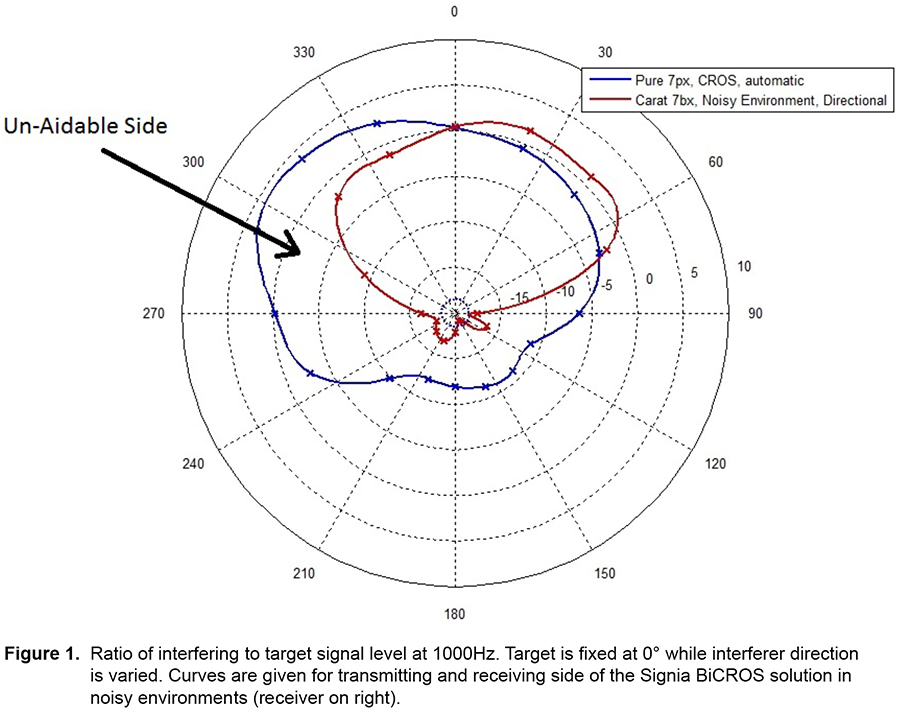
CROS Clinical Study
A clinical study was designed to evaluate the effectiveness of the CROS processing for assisting in the understanding of speech. For the person with single-sided deafness, the most demanding task is speech understanding in background noise when the speech is originating from the bad side. This study, therefore, was designed to have the target speech signal originate from the worse hearing side of the participant, with the competing noise directed toward the better ear.
All participants had normal or near-normal hearing in the good ear, and an unaidable hearing loss in the bad ear. The speech task was understanding key words embedded in sentences with speech-shaped noise present. The task was scored to determine the SRT-50, the SNR where 50% of the words were correct. Testing was conducted with the transmitter microphone on versus off, to establish an SNR benefit score.
The results of this testing, expressed as mean SNR benefit, are shown in Figure 2. Also shown in Figure 2 is the maximum SNR benefit reported by Roikjer (2013) and Steitz (2011) for two competitor CROS systems using a similar test paradigm. Observe that the benefit for the Signia primax of 5.8 dB is more than 1 dB better than Competitor A, and over 2 dB superior to Competitor B. While the participants’ absolute aided scores varied considerably, from –2 dB to -8 dB, the mean 5.8 dB benefit for Signia was relatively consistent among participants, as benefit scores fell within the narrow range of 5.4 to 6.2 dB. The Signia CROS benefit of 1-2 dB SNR, as compared to competitive models, would be expected to improve speech understanding by as much as 10-20%, depending on the listening situation.
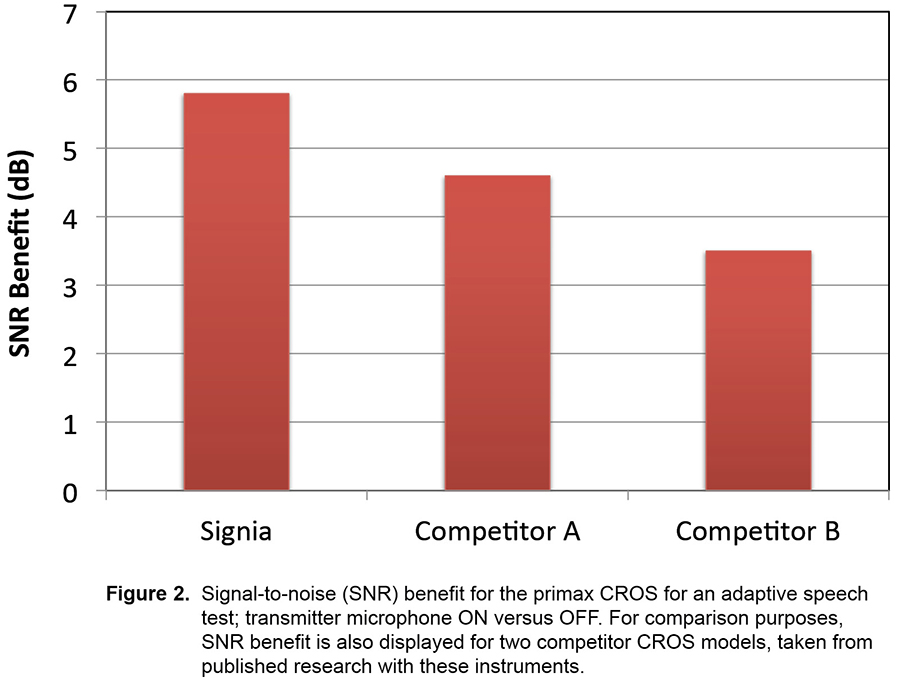
BiCROS Clinical Study
A second study was conducted to evaluate the effectiveness of the primax BiCROS solution. All participants had an unaidable hearing loss in one ear, and a significant hearing loss in the “good” ear that warranted amplification. Again, the participants were fitted with Signia primax mini-BTE RICs, programmed for BiCROS processing; the eartip varied from open to a closed dome depending on the degree of hearing loss in the aided ear. The hearing aids were programmed according to Signia’s proprietary primax fit, optimized for the best mixing of the transmitter and receiver-side speech signals based on subjective assessment and probe-microphone measurements.
Speech recognition testing was conducted to simulate a “worse case” listening situation, with speech delivered to the worse-hearing ear, and noise (multi-talker babble) delivered to the better-hearing ear. The SNR was fixed at +5 dB, with the speech signal delivered at 60 dB SPL, and scored as percent correct for individual words. The mean results for this testing are shown in Figure 3. Displayed are the results for 1) unaided, 2) when only the microphone of the aided ear was activated (i.e., a unilateral fitting) and 3) when both the transmitter microphone (worse-hearing ear) and receiver microphone (better-hearing ear) was activated. As shown in Figure 3, average data reveals a ~30% improvement when the hearing aid on the aided ear is turned on, but speech recognition is still only around 50%. This illustrates the shortcoming of a unilateral fitting for this hearing loss population in this type of listening condition. Observe that when the transmitter microphone was activated, an additional 40% improvement was obtained, placing the average speech recognition score above 90%. This clearly illustrates the advantage of the BiCROS fitting.
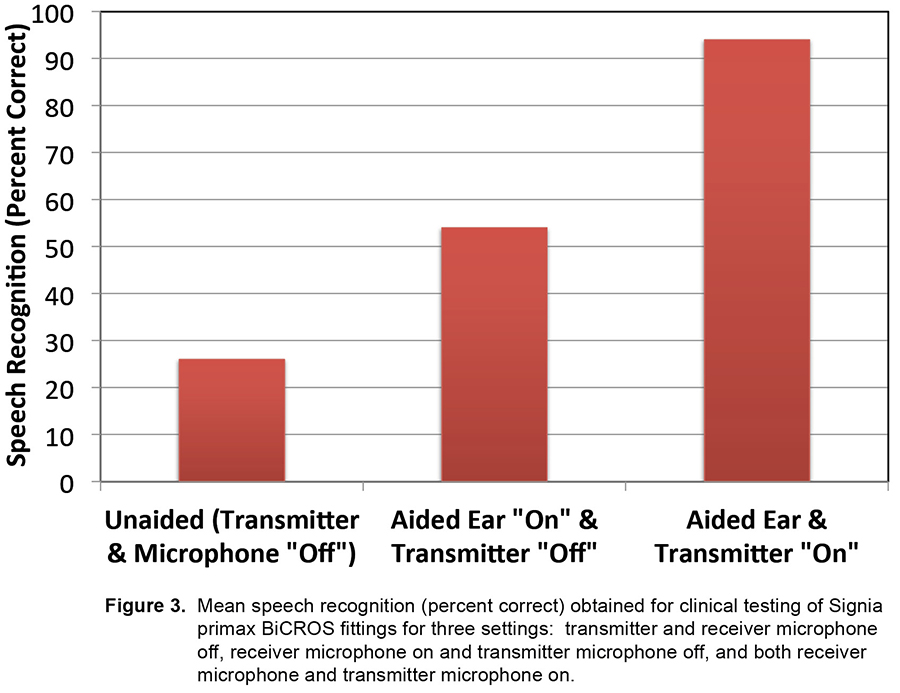
This speech recognition test paradigm was intended to simulate a difficult listening situation, and consequently it also is the situation where the most benefit will be present. It is fair to point out, that if the noise were originating from the side of the bad ear and speech is from the side of the good ear, activating the transmitter microphone will make speech understanding worse, not better. In this case, the patient can simply switch to Program 2, which can be programmed to either have a lower volume for the transmitted signal, or de-activate the transmitter completely.
Following the clinical testing, all participants used the experimental hearing aids in their normal environment for 7-10 days. They were asked to keep a diary regarding when they found the hearing aids beneficial. While all reported significant benefit in the expected quiet listening conditions and hearing soft speech, we were encouraged to hear that they all also reported benefit for communication in background noise. This included understanding at a party, at a wedding dance, in a big box store, in the car, walking and talking with traffic present, and in noisy restaurants. Interestingly, nearly all the participants also reported benefit for sound awareness and localization, although we don’t commonly think of a BiCROS fitting helping with localization. Specific examples included voices in a shopping mall, voices in the work environment, and localization of birds when hearing a bird call.
All participants in this study were specifically selected because they were current users of wireless BiCROS technology from a different manufacturer (Brand B). They were all experienced full-time users of their current hearing aids, and had been fitted within the past three years. A component of the field study, therefore, was for the subjects to complete a questionnaire which compared the Signia primax BiCROS product to their personal Brand B hearing aids during real-world use. The possible ratings were The Same, Slightly Better, Moderately Better, or Definitely Better for Understanding Speech In Quiet, Understanding Speech In Noise, Overall Sound Quality, Localization of Sounds, and Overall Preference.
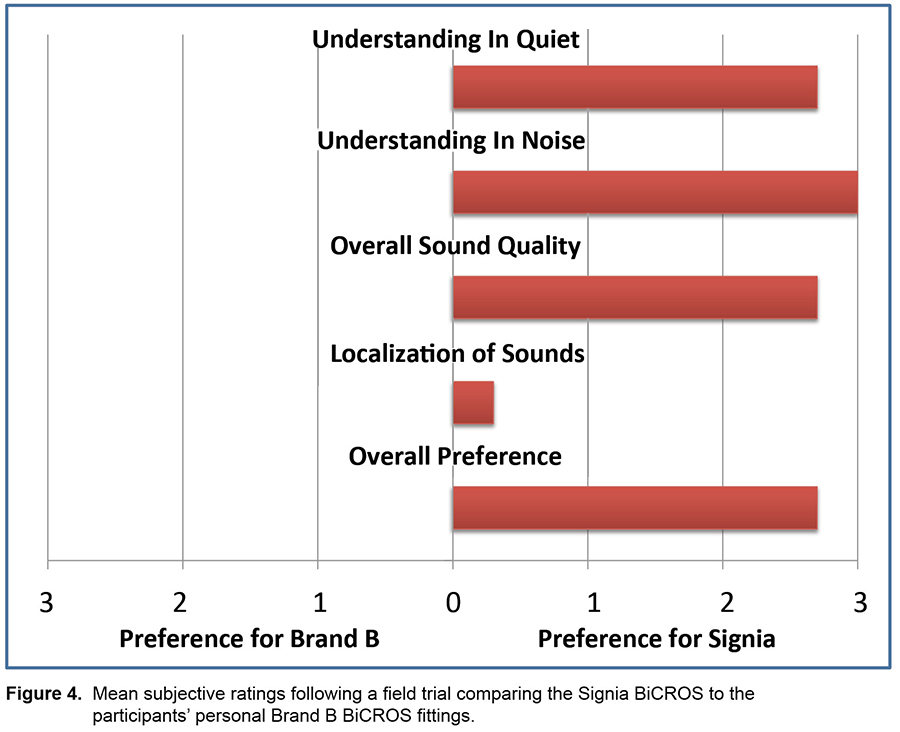
The results of the Signia vs. Brand B comparisons are shown in Figure 4. As clearly shown, there were highly superior ratings for the Signia primax BiCROS solution; mean data were in the “Definitely Better” range for all the parameters involving speech understanding and sound quality. The skeptic reader might suggest that this overwhelming preference could be partly attributed to a Halo, Hawthorne or placebo effect—that is, there was no blinding of the participants or the experimenter. However, note that there was no significant preference for the Signia product for localization (and we wouldn’t expect there to be), which suggests that the participants were not just “checking off” what they might have thought was the “correct” response. Moreover, unsolicited comments on the rating sheets also confirmed the mean data. Responses included: “The differences are like night and day”, “I wish I hadn’t just bought those other hearing aids”, and, “This will be the product I purchase when I need new hearing aids.” Also, although not a specific question on the survey, several participants commented on how long the batteries lasted compared to their Brand B hearing aids, saying that they didn’t have to change batteries for the entire 10 days of the field trial.
Illustrative Cases
We will briefly review three illustrative cases from the BiCROS clinical study. Their audiograms are shown in Figure 5. What these three cases have in common is that they all had symmetrical hearing until the past few years. It may be that this type of patient is more appreciative of the BiCROS solution than someone who has always had one bad ear.
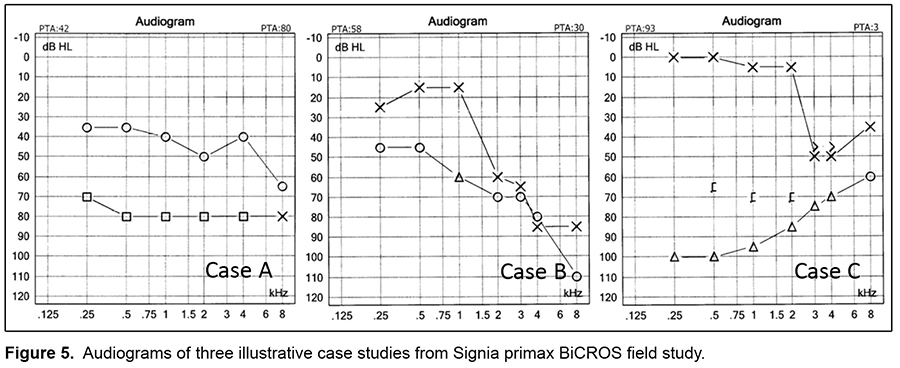
Case A: This patient is a retired 79-year-old female. She suffered a sudden hearing loss three years ago, with little or no recovery since that time. Prior to the sudden loss in her left ear, her hearing thresholds for that ear were similar to those of the right ear. She had previously admitted having some problems, but didn’t think she was ready for amplification. The sudden drop in hearing in her left ear, however, caused significantly more communication problems, and she was fitted with a BiCROS. During her trial with the Signia BiCROS, she reported increased benefits for a variety of conditions including hearing soft speech (her granddaughters) and better speech understanding for different environments with background noise, such as restaurants and parties.
Case B: This patient, a 67-year old male, also had a sudden hearing loss two years ago. Initially, his thresholds in the right ear were 70-90 dB, and then recovered to the current levels, and have been stable for the past year. Based simply on the pure-tone thresholds, this patient might be considered a candidate for bilateral hearing aids, rather than a BiCROS. However, immediately after the sudden hearing loss, his word recognition in the right ear went from 94% to 0%, and even though hearing thresholds have recovered by 30-40 dB, his word recognition did not, and has been in the 6-12% range in recent testing. He is a full-time BiCROS user, and following use of the Signia primax reported significant benefit when working outside, in shopping malls, riding in a car, and understanding speech in noisy restaurants.
Case C: This 51-year-old male works in hospital administration. He was first seen in 2010, at which time his hearing in his right ear was similar to that of the left (he enjoys hunting, which implies probable noise-induced loss), although there was some slight asymmetry. Within a year, the hearing loss in the right ear continued to progress, and radiologic studies determined the cause was a tumor within the cochlea. Word recognition also was very poor. His hearing loss continued to progress, and he was fitted with a BiCROS instrument three years ago and is a full-time BiCROS user. Following the field study he reported significant benefit for family activities, restaurants and meetings. Because of his active lifestyle and varied listening conditions, we thought that he might find it useful to turn off the transmitter microphone for some speech-in-noise conditions, which was an option with the primax hearing aid he was using during the field trial. He reported, however, that even in difficult listening situations he was understanding speech well enough that he didn’t find this option necessary. Interestingly, he also reported the ability to localize talkers at work with the BiCROS fitting.
Summary
The patient with unilateral hearing loss often has significant communication problems, and is looking for a treatment solution. While CROS and BiCROS fitting arrangements have been available for over 50 years, these hearing aid styles have only been met with marginal success, possibly due to the cumbersome nature of the instruments themselves, and the signal processing applied. These issues have been addressed in the new Signia wireless CROS and BiCROS solutions. Featuring an effective fitting algorithm, very low noise floor, a directional pattern skewed toward the worse-hearing ear, and very low power consumption, these new solutions have shown to provide significant wearer benefit in clinical studies, home trials, and case studies. Advantages are also apparent in comparisons to similar alternative solutions available on the market.
References
Bess FH, Tharpe AM, & Gibler AM. (1986). “Auditory Performance of Children with Unilateral Sensorineural Hearing Loss”. In Bess FH et al., Children with Unilateral Hearing loss. Ear and Hearing Monograph, Jan Feb.
Froehlich, M., & Powers, T. (2015). Improving Speech Recognition in Noise Using Binaural Beamforming in ITC and CIC Hearing Aids. Hearing Review, 22(12), 22.
Gehlen, J. (2016). The new primax CROS/BiCROS. AudiologyOnline. Available at:http://www.audiologyonline.com/audiology-ceus/course/quick-tips-meet-new-primax-27392
Herbig R, Barthel R, Branda E. (2014) A history of e2e wireless technology. Hearing Review. 21(2): 34-37.
Harford, E., Barry, J. (1965). A rehabilitative approach to the problem of unilateral hearing impairment: Contralateral routing of signals (CROS). J Speech Hear Dis, 30, 121-138.
Kamkar-Parsi, H., Fischer, E., & Aubreville, M. (2014). New Binaural Strategies for Enhanced Hearing. Hearing Review, 21(10), 42-45.
Littmann, V., Junius, D., & Branda, E. (2015). SpeechFocus: 360° in 10 Questions. Hearing Review, 22(11), 38.
Powers, T. & Froehlich, M. (2014). Clinical Results with a New Wireless Binaural Directional Hearing System.Hearing Review, 21(11), 32-34.
Roikjer, M. (2013). Improving speech intelligibility with Widex CROS. Widexpress, 33.
Steitz, C. (2011). Phonak CROS: A ‘quantum leap’ for people with total unilateral hearing loss. Phonak Field Study News.
Teder H. (2014). The first wireless CROS. Canadian Audiologist, 1(2). Available at:http://canadianaudiologist.ca/issue/volume-1-issue-2-2014/column/stories-from-our-past


